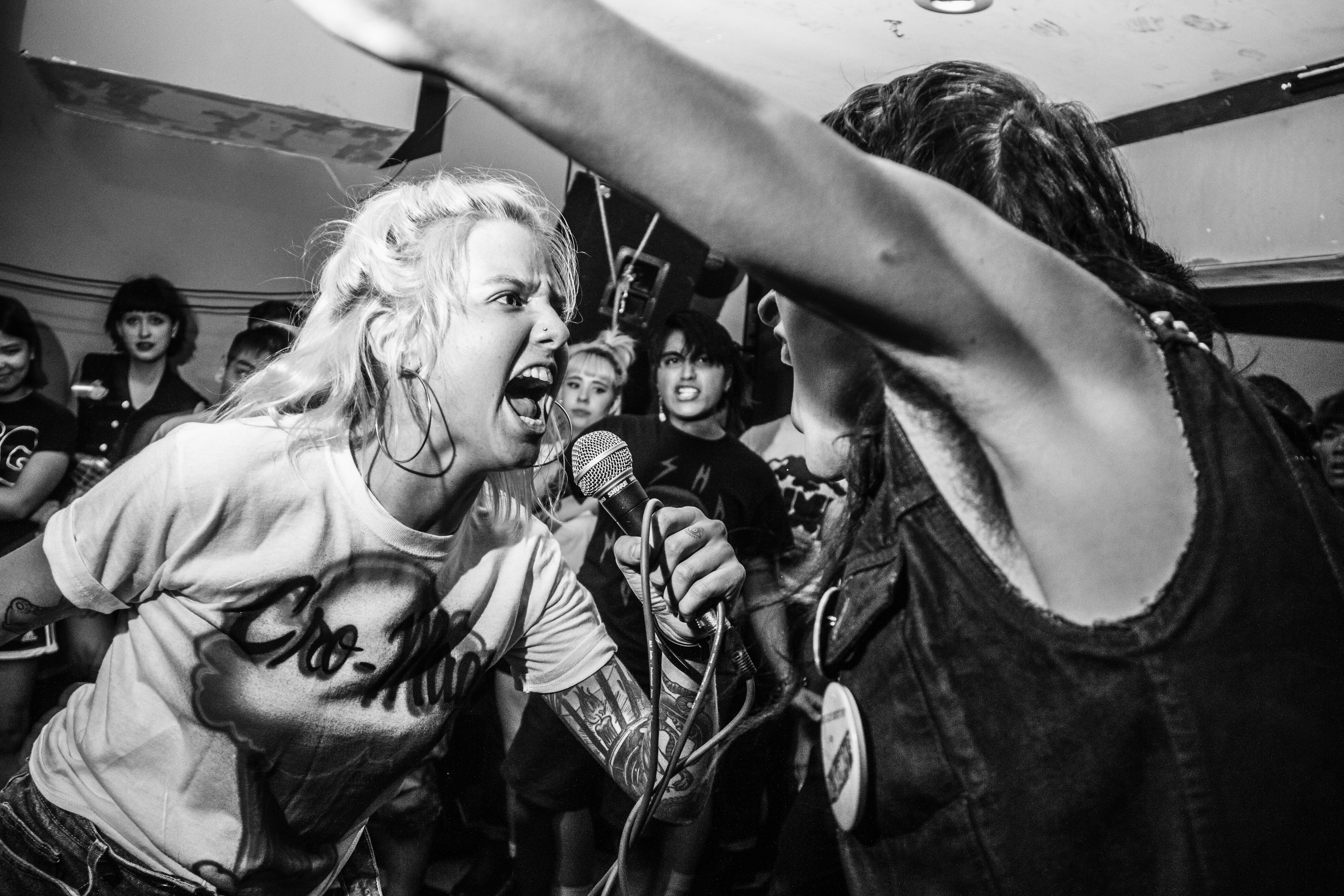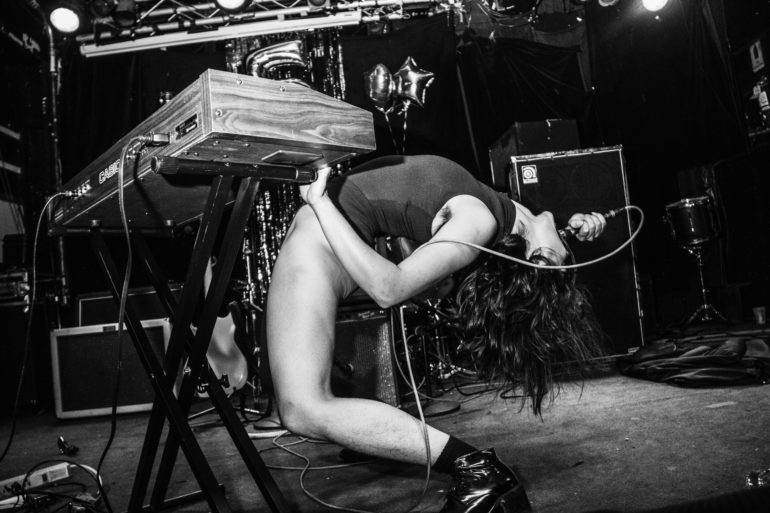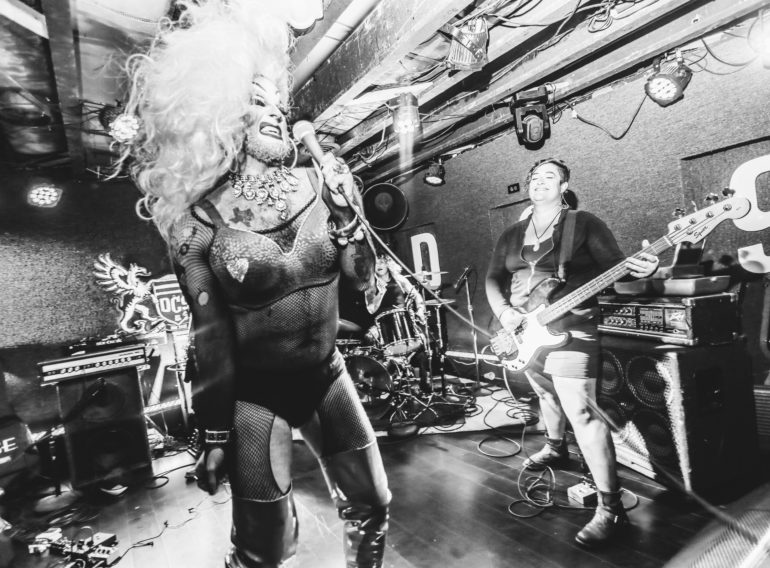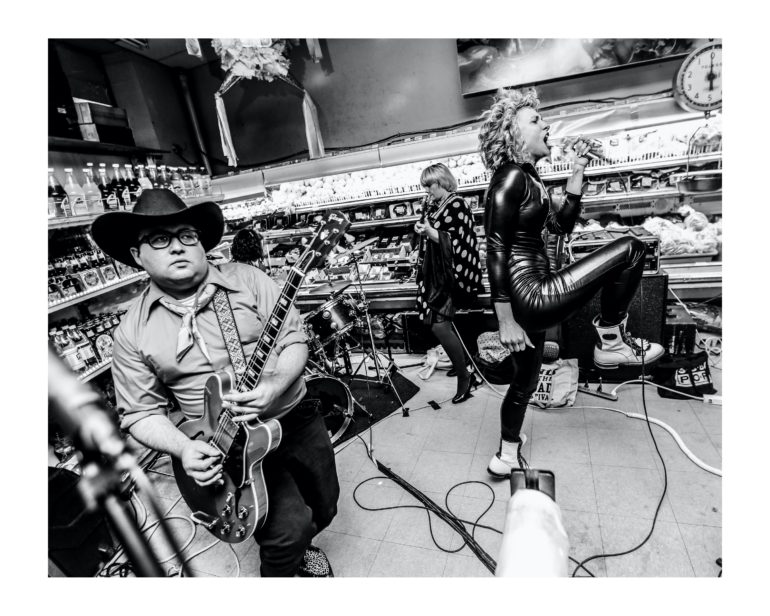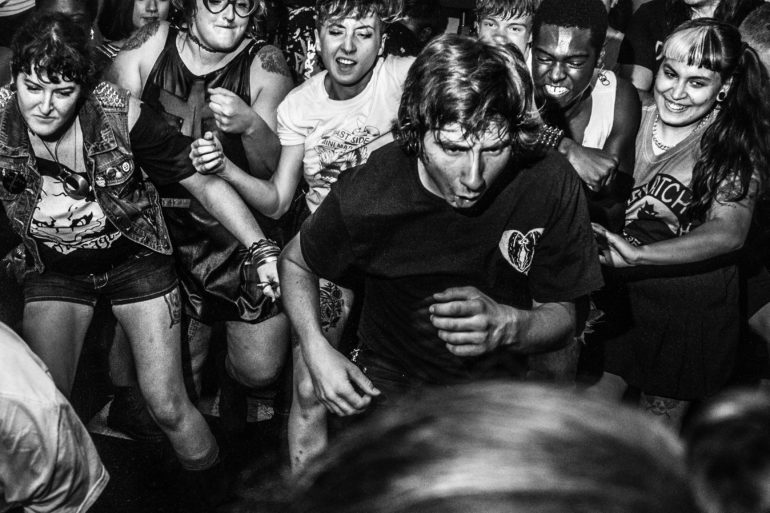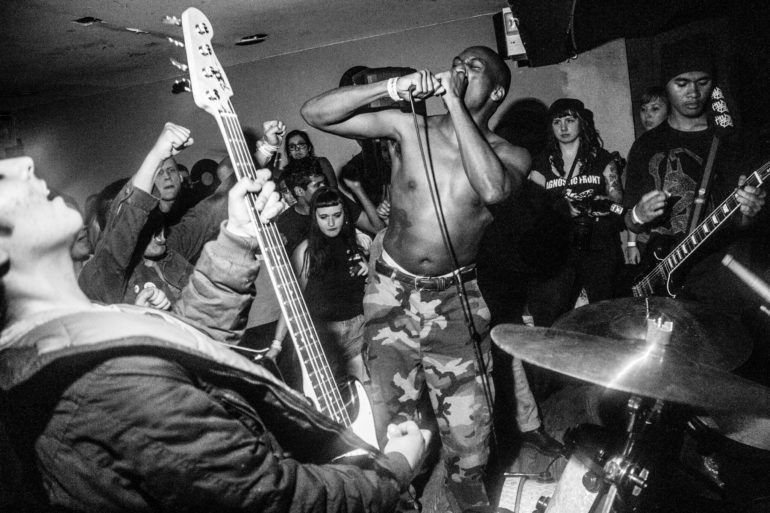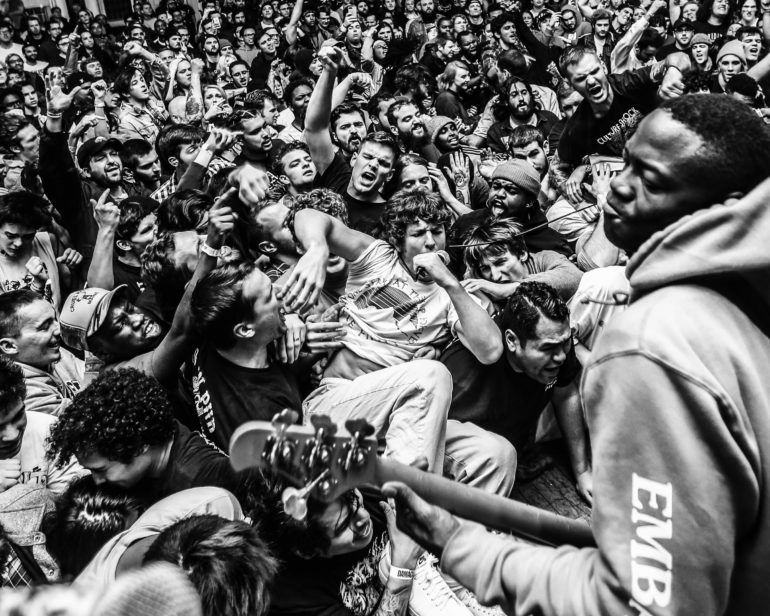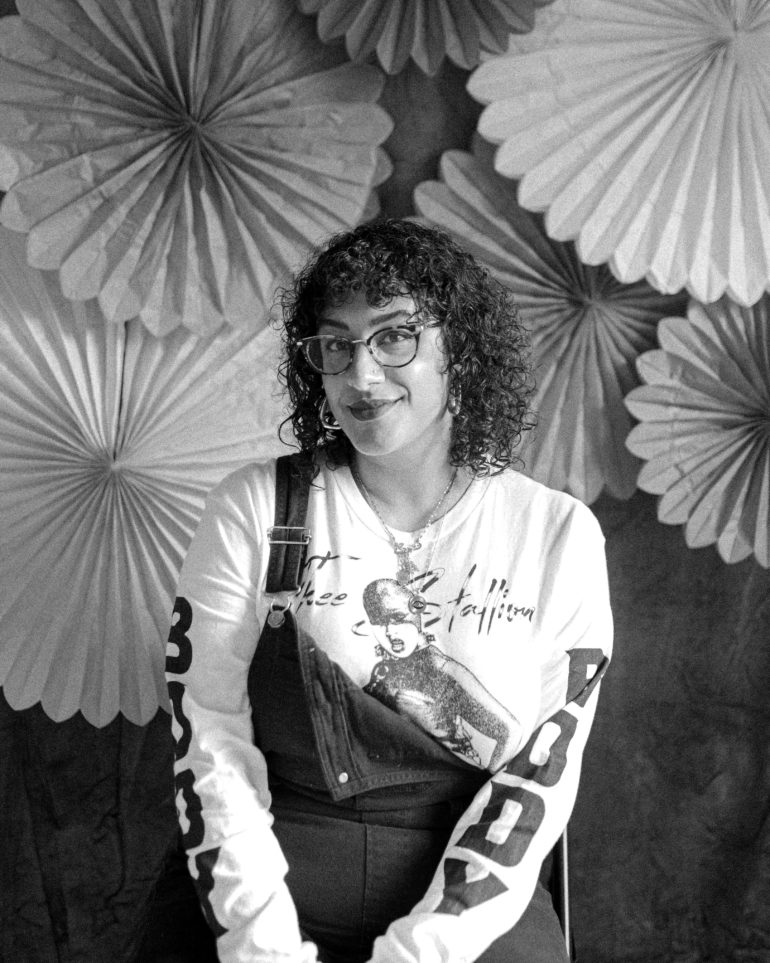“Listen, it’s not ‘thirty, flirty, and thriving,'” explains photographer Farrah Skeiky to us in an interview. “It’s ‘thirty, flirty, and if the shoe doesn’t have the word Air or Jordan in the name, I’ve put in gel insoles,’…I stretch, I drink at least a gallon of water every day, and I take my vitamins.” Farrah embodies lots of the ideals of the modern punk and hardcore scene in her photography. She’s done lots of diversity, LGBTQ+, and cause-centered work over her career. And like lots of other photographers, she couldn’t wait to get back to shooting when the pandemic died down a bit.
Farrah’s work is fascinating. Her photos are black and white, but she’s not big on nostalgia like many trends are. She’s looked at a ton of old punk zines, and noticed how the people of the punk rock scene have changed over the years. Her work makes you feel like you’re at a show, about to get elbowed at any moment.
This work is from her book Present Tense. Give it a purchase if you love what you see.
The Essential Camera Gear of Farrah Skeiky
When I photograph smaller shows and any kind of queer nightlife, I have to have an off-camera flash. I rely on a combination of a Canon Speedlite 430EX on a Vello TTL Off-Camera Flash Cord. These two things give me a lot of flexibility in how I direct a shadow, and what is clearest in a photograph. For those little basement venue shows, I love the Canon EF 16-35 to get as many band members and folks in the crowd as possible in every shot.
For portrait photography, I still haven’t found anything that I like more than a Sigma Art 35mm. It’s simple, light, and not as intimidating for the subject sitting across from me – and many of those folks are not in the habit of being photographed regularly.
Over the years I have grown beyond punk and DIY gigs and found myself in situations where I couldn’t be as close to the subjects as I wanted. I finally got my first telephoto lens last year, a Canon EF 70-200MM F2.8. As someone who is more of a documentarian, the last thing I want to do is interrupt a scene I’m trying to photograph – and this lens lets me get up close without physically altering what is happening.
Phoblographer: Talk to us about how you got into photography.
Farrah Skeiky: I got into photography in high school when my dad became ill. I had just got my hands on my first proper camera. I wouldn’t call my dad a photographer, but he was definitely the family documentarian, and I remember many trips to Costco that included stopping to drop off film or pick up prints. It wasn’t my intention to “take over” for him, but it happened. I would take my little Canon Rebel with me everywhere – to school, to friends playing little house shows, etc.
Phoblographer: What made you want to document the punk scene?
Farrah Skeiky: Even though I had been playing instruments since middle school, I had never really pictured myself being in the bands. I fell in love with zines and the art on album covers and in the inserts in high school. I was already in a rhythm of documenting my life, and as I started going to more punk shows, I would bring my camera. The barrier of entry was lower. I wasn’t under the pressure of a deadline, and I could practice with or without flash, which was not uncommon in these rooms.
Most importantly, I was struck by how different punk and hardcore looked now than it did in the old zines and record inserts I saw growing up. I had seen some gender diversity, but not a lot of racial diversity, and certainly not a lot of LGBTQIA+ diversity in those older photos, and now I was entering rooms where all kinds of folks were participating – whether they were playing in the show, booking it, or had made the flyer for that gig. I thought it was really important to capture that.
Phoblographer: I grew up in the punk scene in NYC. It was pretty easy to gain access to these artists, correct? Were there any sorts of hardships or difficulties you needed to navigate?
Farrah Skeiky: Moving to the DC area from Seattle and its surrounding suburbs was a game-changer for a pre-teen me. Seattle wasn’t great for all-ages shows at traditional venues when I lived there, and unless you were a really cool 8th grader, you probably weren’t getting a hookup for house shows or other gigs in less conventional spaces. But DC’s continued tradition of all-ages shows, and many accessible shows less than $10 made participating a lot easier. You just showed up. It has always been really welcoming, and to be honest, the only hardship I have had to navigate is my own social anxiety. Sometimes the camera is a way to start a conversation, and sometimes it’s a way to close yourself off. I would like to say that I’ve mastered that anxiety since I started photographing shows 12 years ago, but that’s not really the case.
Phoblographer: Why black and white? Going through your portfolio, it seems most of your deeply personal work is black and white while the rest is in color.
Farrah Skeiky: It may sound strange, but I am usually pretty anti-nostalgia. I think being steeped in it can make you complacent and can make your work derivative. There’s a big difference between paying homage/making your influences known and just parodying something else. But I wanted to make images that at first glance were not that different from your classic hardcore punk photo, but made you do a double-take to spot the differences between Then and Now. What kind of people do you see in these images, that you didn’t see 20, 30 years ago?
I stuck with black and white for a long time because I wanted to play up the things I loved about those moments that weren’t color – textures, physical interactions, extreme emotional expressions. But in recent years I’ve worked in color a lot more. I photograph a lot of things beyond punk and hardcore – lots of drag, where performers have put lots of time into their looks; lots of food, and lots more photojournalism work. Most of my personal photography documenting my pandemic life and the relationships inside of that has been in color. I don’t want to limit myself. I get bored if I’m not learning.
“Most importantly, I was struck by how different punk and hardcore looked now than it did in the old zines and record inserts I saw growing up. I had seen some gender diversity, but not a lot of racial diversity, and certainly not a lot of LGBTQIA+ diversity in those older photos, and now I was entering rooms where all kinds of folks were participating – whether they were playing in the show, booking it, or had made the flyer for that gig.”
Phoblographer: Concert venues and bars are one thing, but churches and convenience stores can be something else. Did these places come with specific challenges that you felt were more difficult to handle? I can’t imagine moving around in a store is that simple while a band is performing.
Farrah Skeiky: If photographing music has blessed me with anything, it’s the skill to be flexible. To be honest, photographing the grocery store gig that you’re referencing wasn’t all that different from photographing a band playing in a living room, which I am extremely used to by now. There just happened to be more green veggies in one than the other.
As far as churches, a lot of my earlier punk shows in DC were at St. Stephen’s Church, which has been hosting punk/HC shows for decades as long as there is a benefit/donation component. It’s a little intimidating shooting from the side of the stage in that setting, but it gives you a great view of the crowd that you normally wouldn’t get in a small basement club or a living room. you get a great sightline for the crowd and the band interacting, too. I love it.
Phoblographer: Talk to us about your influences. Do you feel like what’s in front of you influences you to push the shutter more, or do you see patterns from your idols in your work at all?
Farrah Skeiky: I’m lucky that a lot of my favorite DC photographers are still alive and well, and within reach. Jim Saah just put out a great photobook called In My Eyes – and how cool is it that one of my all time favorite punk photographers is also Arab?! I recently had the opportunity to frame Leslie Clague’s work and show my own work alongside hers at a show at Spring Break Art Fair. And Lucian Perkins is even putting out a 2nd edition of Hard Art DC 1979 later in April.
But when I’m in the pit, it’s all about the people in front of me. It’s that anti-nostalgia again. I love all of those photographers, but I want my work to stand on its own. I want it to keep growing and changing. We’re talking about capturing specific moments in time that are incredibly unique.
Phoblographer: What have been some essential, non-camera items for you when doing this kind of work?
Farrah Skeiky: Listen, it’s not “thirty, flirty, and thriving.” It’s “thirty, flirty, and if the shoe doesn’t have the word Air or Jordan in the name, I’ve put in gel insoles.” And I hate wearing contacts, so I’ve always got an extra pair of glasses in my bag. But the most important things, in this case, aren’t things. I stretch, I drink at least a gallon of water every day, and I take my vitamins. I just started weight training with Zech Ghosttribe, who drums in DC band Asesinato. I want to do this work for a long time. Photographers hate when people chalk up our nice photos to our nice gear, right? Because we know that we make those photos great. If you are your best asset, you need to take care of yourself the same way you care for your gear, or better!
Phoblographer: What was the pandemic like for you? Did the DC Punk scene fizzle out a bit?
Farrah Skeiky: My pandemic experience kicked off with getting laid off from my day job, and then breaking my foot and spraining my ankle a week after my health insurance ended, so I was solidly at home. The punk scene here was quiet, but that was the case for a lot of punk scenes. Especially when lots of its members are working jobs that were cut during the pandemic – no one needed servers or dog walkers for a while. But I saw a lot of people looking out for each other, creating benefit zines, and making sure everyone was ok and had what they needed to get by. There’s a big difference between a scene and a community.
Phoblographer: What are the most important moments to shoot? Your work is a mix of crowd interactions and what seems to be environmental musician portraits.
Farrah Skeiky: I wouldn’t say that anyone is more important than the other, but I adore photos when you can’t tell who is a band member and who is part of the crowd. The energy of the night needs to come from both sides of the stage. As for portraits, they used to intimidate me. Capturing someone doing their thing and just keeping up with them is one thing, but having someone sit still and get comfortable enough to show you who they are is a whole other challenge, and the pandemic forced me to own it.
About Farrah Skeiky
Farrah Skeiky is an Arab American photographer and creative director based in Washington, DC. Her work celebrates those who make and do in their element. She began photographing live music in 2008, focusing primarily on punk, DIY, and drag communities. Skeiky highlights race and gender inclusion within these groups and examines how transience works for and against them in an ever-changing city. Her photo book PRESENT TENSE: DC Punk and DIY, Right Now was released in 2020, and her work has appeared in Rolling Stone, The Wall Street Journal, The Washington Post, She Shreds, Pitchfork, Food + Wine, Bon Appetit, Guitar World, and more. Skeiky is a member of Women Photograph, Diversify Photo, To The Front, and Women Photojournalists of Washington.
All images used with permission. Check out more from Farrah at her website, Instagram, and Twitter.


